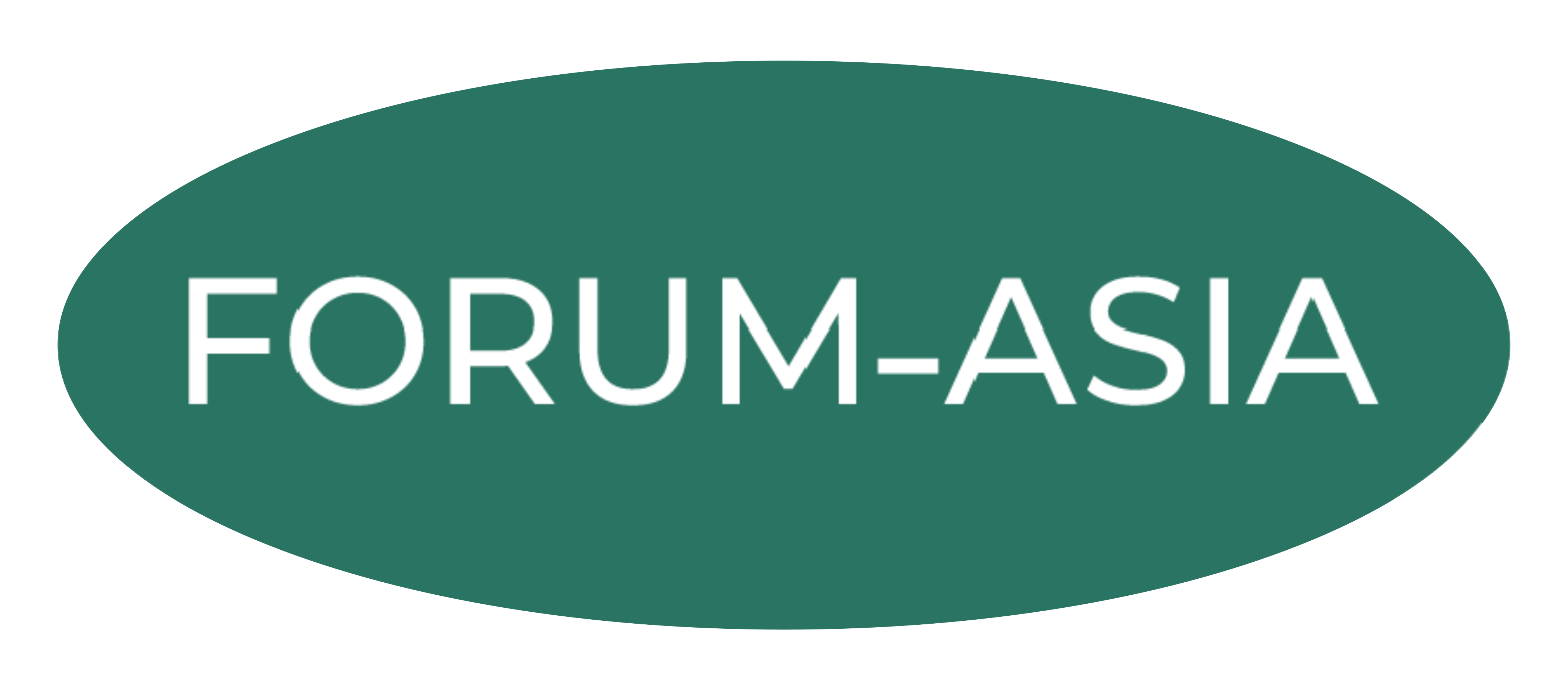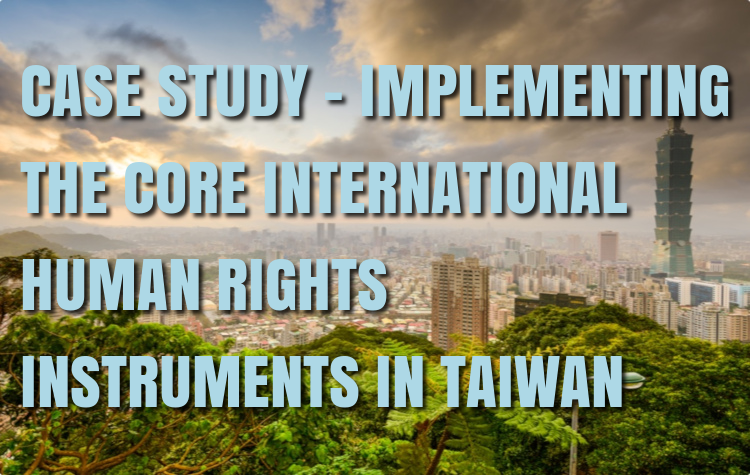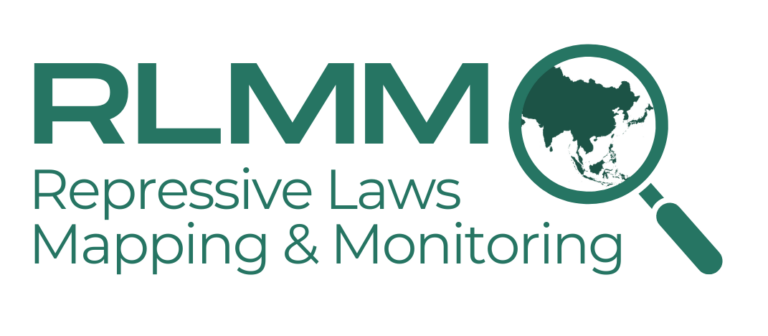FORUM-ASIA organised its first Global Advocacy Learning Programme (GALP) on Human Rights and Development in Thailand on 19-25 November 2017. Prior to the event, participants were asked to submit case studies on specific issues related to human rights or development, with a particular focus on the role played by civil society organisations in addressing the issues. For more information on this year’s GALP, click here. Below is a case study written by one of the participants of the GALP in 2017.
Disclaimer: The views and opinions expressed in this article are those of the author, and do not necessarily reflect those of FORUM-ASIA. Assumptions or recommendations made based on the analysis in the article, should also be accredited to the author, and do not always align with policies or positions of FORUM-ASIA.
Implementing the Core International Human Rights Instruments in Taiwan
by Jou An Chen
Since the Nationalist Party – Kuomintang (KMT) lost the Chinese civil war in 1949, the effective jurisdiction of Republic of China (ROC) has been limited to Taiwan[1] and its surrounding islands. It not only ceased to represent China but also became a non-member of the United Nations (UN) in 1971. In that year, the People’s Republic of China (PRC) led by the Chinese Communist Party was instead recognised as the sole legitimate government representing China in the UN. The PRC has and continues to assert Taiwan to be one of its provinces rather than an independent country. As a non-member, the ROC has no access to the UN human rights mechanisms.
Nevertheless, to fully integrate the values of democracy into the society, and at the same time watch over the expansion of PRC’s control over Taiwan, the Taiwanese non-governmental organisations (NGOs) has sought guidance from the international human rights system. Despite the country’s inability to join the UN treaty bodies,[2] Taiwanese NGOs urged the Government to accede to the core international human rights instruments. This article will briefly provide a historical background of the ROC, and demonstrate how the Taiwanese model of holding national reviews without assistance from the treaty bodies contributes to the implementation of the human rights instruments, while concurrently facilitating the creation of NGO networks operating in various fields.
Becoming a non-member of the UN
The UN resolution that denied Taiwan’s participation as a State in the UN originated from the dispute between the ROC and the PRC, as they both claimed to represent legal China. In 1895, the Qing dynasty signed the Treaty of Shimonoseki, and Taiwan as a province was ceded to the Empire of Japan. Taiwan was a Japanese colony until the end of World War I.
Meanwhile, the Chinese Civil War was raging on mainland China, as the Chinese Nationalist Party (KMT) battled with the Communist Party of China. Founding the ROC regime, the KMT’s military occupancy of Taiwan was entrusted by the Allies in 1945,[3] and the ROC Government represented China before and after establishment of the UN. Yet, in 1949, the KMT was defeated, and the Communist Party founded the PRC on mainland China and claimed Taiwan to be part of its provinces. The KMT, led by Chiang Kai-Shek, retreated to Taiwan. With military support from the United States to confront the PRC during the Cold War, the ROC further justified its occupancy of Taiwan.[4]
Due to a shift in international relations, the PRC became more and more influential in the international political sphere. In 1971, the UN General Assembly passed Resolution 2758 which expelled the ROC and recognised the PRC as ‘the only legitimate representative of China’ to the UN and organisations related to it.[5] The PRC also replaced the ROC as one of the five permanent members of the Security Council, which consequently conferred the power to veto any UN membership application of the ROC. The PRC claims Taiwan to be a province of China, whereas the ROC claims Taiwan to be its rightful territory. The issue of self-determination of the people of the island thus remains unresolved.
The need for human rights protection
Taiwanese civil society has had to simultaneously fight against the authoritarian regime of ROC and the military threat of PRC, which had been growing increasingly stronger because of China’s economic success under globalisation. The ROC’s coercion and corruption stimulated uprisings from the public, and the ROC Government announced the imposition of Taiwan Martial Law in 1949 in response, carrying out prosecution and political executions. Despite overall economic growth under its one-party rule, unequal distribution of wealth, along with Resolution 2758 that expelled the ROC from the UN, triggered instability and made the KMT slowly loosen its control. President Chiang Ching-Kuo, Chiang Kai-Shek’s son and successor, lifted Martial Law in 1987.
Despite the fact that the PRC used military threat with the aim to influence the election of Taiwan, Lee Teng-Hui of the KMT won the first direct presidential election in 1996, while Chen Shui-Bian of the Democratic Progressive Party (DPP) became the first non-KMT President in 2000; he was re-elected in 2004.[6]Democratisation was moving forward, but the DPP’s policies, which provoked forced evictions, made farmers let their lands lie fallow and harmed the most vulnerable people in the country, cast a shadow over its administration.[7] President Ma Ying-Jeou of the KMT took office in 2008 and got re-elected in 2012. The interest-oriented KMT pandered more and more to the PRC, and President Ma’s increased interactions with the Chinese officials stirred up protests against KMT’s pro-PRC policies.[8]Under Ma’s populist presidency, the human rights situation in Taiwan deteriorated, with the re-execution of the death penalty, widespread land grabbing, and increased Chinese influence on media censorship.[9]
To incorporate the human rights instruments
The ROC has gone through democratisation, but difficulties arise because of its UN non-member status and consequent lack of international support. In this context, Taiwanese NGOs have pushed hard to incorporate core international human rights instruments in order to improve the protection and promotion of human rights. When Chen Shui-bian won the presidential election in 2000, the President Office Human Rights Consultative Committee (POHRCC) was established, opening up a channel for NGOs to influence policies. However, the bill to nationally endorse the International Covenant on Civil and Political Rights (ICCPR) and the International Covenant on Economic, Social and Cultural Rights (ICESCR) failed to gain approval, because the KMT still had a majority of the seats in the Legislative Yuan.[10] Legislators even claimed POHRCC was unlawful, and President Chen dismissed the committee in 2006. NGOs did not give up, and eventually in 2007the Legislative Yuan approved the resolution to join the Convention on the Elimination of all Forms of Discrimination Against Women (CEDAW).
Whether the intention was to truly protect human rights, to generate political goodwill, or otherwise, in 2010 President Ma Ying-jeou re-established the POHRCC, and the Legislative Yuan with a KMT majority hastily passed the Act to Implement the International Covenant on Civil and Political Rights and the International Covenant on Economic, Social and Cultural Rights (hereinafter Implementation Acts) without reservation in 2009.[11]Considering the violations of human rights taking place in the country, NGOs, though baffled by the accession, seized the opportunity to keep pushing the Government to incorporate other conventions via the Implementation Acts.[12]
The Taiwan Model in practice
According to the Implementation Acts, as the ROC cannot submit reports to the UN Treaty Bodies, it invites independent experts, former members of UN committees, scholars, judges, or foreign National Human Rights Institutions (NHRIs) officials, to form review committees and hold international reviews. A subsequent review would be held after four or five years and a new review committee would be formed. In order to participate and monitor the implementation more effectively, Taiwanese NGOs actively engaged the POHRCC to facilitate the reviewing agenda.
In 2013, when the initial national review of two Covenants was held in Taipei, the ICCPR review committee and the ICESCR review committee, each consisted of five independent experts, were invited to Taiwan. Taiwanese NGOs tried to gain an equal status with Government officials to hold sessions of constructive dialogues with the committees. The initial five-day review of the two Covenants became the Taiwan model of treaty reporting.
Since the review sessions are held in Taipei, many officials and NGOs are able to attend. The international reviews also provide an opportunity for the Taiwanese civil society to build up networks.
For instance, Covenants Watch coordinated with 80 NGOs to publish a compact parallel report for the second two Covenants periodic reviews in January 2017. Among the 80 organisations were very few disabled persons’ organisations (DPOs) though, so the initial review of the Convention on the Rights of Persons with Disabilities (CRPD) in October 2017 turned out to be a platform for DPOs to collaborate with other NGOs.
An example of organisations campaigning against forced evictions is worth noting too, though many were community-based and seldom got in touch with others. A number of forced-eviction organisations gathered during the initial two Covenants review in 2013, and the Taiwan Alliance of Anti-Forced Eviction (TAAFE) was later founded. In cooperation with Covenants Watch, TAAFE coordinated with more than ten communities to join the drafting of the parallel report in 2017.
It appears that this model of five-day international reviews gives Taiwanese NGOs more advantages in terms of participation. Also, the review committees are not burdened with a backlog of reports from other countries. However, without assistance from the UN Treaty Bodies, the Taiwanese model has to rely on the Government to initiate each review and sponsor independent experts to form a review committee. In addition to this, the review committees cannot carry out supportive activities like the UN Treaty Bodies, such as receiving individual communications, and as their term normally last less than one year, it is impossible for them to follow up on the concluding observations.
In other words, the Taiwanese model requires civil society’s dedication to implement. To track the implementation of the concluding observations, the Taiwanese Government submitted Response to the Concluding Observations and Recommendations Adopted by the International Group of Independent Experts on March 1, 2013 in addition to the national report before the second two Covenants periodic review, and the civil society also submitted a parallel document. The Government has also held concluding observations’ follow-up meetings.[13]
The importance of the Taiwanese Model
While the international human rights system has been adapting to cope with abuses beyond State boundaries, the Taiwanese model’s limitations reveal deficiencies due to the lack of international support. On the one hand, being denied to join the UN Treaty Bodies, the ROC is unable to contribute to the strengthening of these bodies, help interpret the instruments, or generate general comments. On the other hand, being denied to join the UN Charter Bodies means that the ROC is deprived of taking part in the Universal Periodic Review (UPR), an important platform for State parties to make an impact on cross-border issues. Since the UN Charter Bodies receive information from the UN Treaty Bodies, it also means that issues in Taiwan do not appear on the agenda of the UPR.[14]
In spite of the country’s uncertain status, Taiwanese NGOs endeavour to incorporate the core international human rights instruments. The fulfilment of democracy in Taiwan should not halt at the realisation of Presidential Elections. The Taiwanese Model is therefore crucial to further the protection of human rights and deepen democratic values. Since the number of Taiwanese NGOs taking part in reviews has risen in the past few years, the Taiwanese model has made positive impacts on society. As Taiwan moves on to apply the criteria of international human rights protection, hopefully, its distinctive experience will contribute to the development of the international human rights system and build up mutual support.
***
For a PDF version of this case study, click here.
***
Footnotes
[1]For the purpose of this article, the term ‘Taiwan’ refers to the island of Taiwan and its associated islands such as Penghu.
[2] Responsible for examining the implementation by States that had ratified the instrument, the treaty bodies complete the mandate of the UN human rights system’s charter bodies, based on the UN Charter. State Parties are obliged to submit a periodic report to the treaty bodies, on the measures as well as on progress made in the enjoyment of the treaty rights. Non-governmental organisations (NGOs) and National Human Rights Institutions (NHRIs) can submit parallel reports and attend the reviews too, while the treaty bodies would review the reports and recommend concluding observations. Even if a State party does not submit any report, treaty bodies would nevertheless hold the review and refer non-submission to the UN General Assembly. Treaty bodies can undertake activities to support treaty implementation, such as to draft general comments, receive individual communications, conduct inquiries, organise country visits, designate rapporteurs, to name a few.
[3] Far East (Formosa and the Pescadores),Historic Hansard: 1803-2005, House of Commons Hansard archives, accessed December 12, 2017. http://hansard.millbanksystems.com/commons/1955/may/04/far-east-formosa-and-the-pescadores#S5CV0540P0_19550504_HOC_582.
[4] The 1951 multilateral Treaty of Peace and the 1952 Treaty of Peace between the ROC and Japan stated that Japan had renounced all right, title, and claim to Taiwan. See Jonathan I. Charney and J. R. V. Prescott, “Resolving Cross-Strait Relations between China and Taiwan,” The American Journal of International Law, Vol. 94, No. 3 (2000): 457-458.
[5]Though the ROC signed the International Convention on the Elimination of All Forms of Racial Discrimination (ICERD), the International Covenant on Economic, Social and Cultural Rights (ICESCR), and the International Covenant on Civil and Political Rights (ICCPR) and its Optional Protocol in the 1960s, the UN has since then deemed the signatories “illegal and null and void”. See “Status of Treaties: International Convention on the Elimination of All Forms of Racial Discrimination”.
[6] Jieh-Min Wu, “Commercialization of China’s United Front Strategy: How Beijing Manipulates Cross-Strait Government-Business Relations,” in Unfinished Miracle: Taiwan’s Economy and Society in Transition, ed. Zong-Rong Lee and Thung-Hong Lin (Taipei: Academia Sinica, 2017), 689.
[7]The eviction of the 14-15 Park informal settlements occurred when Chen was the Mayor of Taipei in the 1990s. In 2003, a farmer, known as the “rice bomber,” tried to dispose bombs in Taipei to raise awareness against the expansion of agricultural imports and joining the World Trade Organization.
[8]In 2008, the Wild Strawberries Movement broke out after the visit of the PRC’s Association for Relations Across the Taiwan Straits chairman Chen Yunlin to Taiwan.
[9]The Government had once stopped executing the death penalty in 2006, but the execution was restarted in 2010. Social movements such as the Dapu anti-eviction protests in the 2010s and the Anti-Media Monopoly Movement in 2012 escalated, and the Occupation of the Legislative Yuan in 2014 broke out in response to the human rights violations, unequal distribution of wealth, and the increasing Chinese influence on the economy.
[10]The KMT legislator considered reserving the right to form trade unions, the right to strike, and the right to self-determination in the two Covenants. Ken H.C.Chiu, “The Background of Implementing ICCPR and ICESCR,” Taiwan Association for Human Rights, accessed December 16, 2017. https://issuu.com/eeling/docs/tahrpas201003.
[11]Commenting on the hastiness, some NGOs pointed out that the sentence, “The right to strike, provided that it is exercised in conformity with the laws of the particular country,” from article 8 of the ICESCR disappeared within the official document the Legislative Yuan had passed, and the Government only corrected it two days before the Two Covenants Implementation Act was promulgated on December 10, 2009. See “The Two Covenants Crippled as the Right to Strike got Erased,” Amnesty International Taiwan, accessed December 16, 2017. https://www.amnesty.tw/node/741.
[12]See table 1 for more information about passing other Implementation Acts.
[13]For example, instead of drafting Implementation Acts outlining the reporting obligations, the Government proposed to incorporate the International Convention on the Protection of the Rights of All Migrant Workers and Members of Their Families (ICRMW) and the International Convention for the Protection of All Persons from Enforced Disappearance (ICED) via the Treaty-Making Act, which only focuses on the accession procedure, during one of the follow-up meetings. The NGOs that attended the meeting have raised concerns towards the Treaty-Making Act, asking the Government to consider the Implementation Act option, and the issue is still under evaluation. See “The First Two Covenants Concluding Observations Follow-up Meeting in 2017,” Ministry of Justice (Taiwan), accessed December 16, 2017. http://www.humanrights.moj.gov.tw/lp.aspctNode=45815&CtUnit=18519&BaseDSD=7&mp=200.
[14]In contrast, China has on occasion adopted positions that seek to diminish the treaty bodies, including opposing reforms that would strengthen them with resources, and attacking the integrity of treaty body members when the Government disputes their findings. The Chinese Government also assertedthat the treaty bodies “should generally respect the mandate of the treaties and refrain from imposing additional burdens on State parties.” See The Costs of International Advocacy: China’s Interference in United Nations Human Rights Mechanisms (USA: Human Rights Watch, 2017), 56-59.




